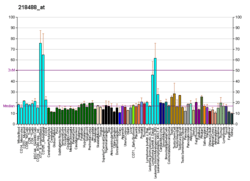EIF2B3
Translation initiation factor eIF-2B subunit gamma is a protein that in humans is encoded by the EIF2B3 gene.[5][6]
References
- 1 2 3 GRCh38: Ensembl release 89: ENSG00000070785 - Ensembl, May 2017
- 1 2 3 GRCm38: Ensembl release 89: ENSMUSG00000028683 - Ensembl, May 2017
- ↑ "Human PubMed Reference:".
- ↑ "Mouse PubMed Reference:".
- ↑ Kruger M, Beger C, Li QX, Welch PJ, Tritz R, Leavitt M, Barber JR, Wong-Staal F (Aug 2000). "Identification of eIF2Bgamma and eIF2gamma as cofactors of hepatitis C virus internal ribosome entry site-mediated translation using a functional genomics approach". Proc Natl Acad Sci U S A. 97 (15): 8566–71. doi:10.1073/pnas.97.15.8566. PMC 26988. PMID 10900014.
- ↑ "Entrez Gene: EIF2B3 eukaryotic translation initiation factor 2B, subunit 3 gamma, 58kDa".
Further reading
- Welsh GI, Miyamoto S, Price NT, et al. (1996). "T-cell activation leads to rapid stimulation of translation initiation factor eIF2B and inactivation of glycogen synthase kinase-3". J. Biol. Chem. 271 (19): 11410–3. doi:10.1074/jbc.271.19.11410. PMID 8626696.
- Gomez E, Pavitt GD (2000). "Identification of domains and residues within the epsilon subunit of eukaryotic translation initiation factor 2B (eIF2Bepsilon) required for guanine nucleotide exchange reveals a novel activation function promoted by eIF2B complex formation". Mol. Cell. Biol. 20 (11): 3965–76. doi:10.1128/MCB.20.11.3965-3976.2000. PMC 85753. PMID 10805739.
- Anthony TG, Fabian JR, Kimball SR, Jefferson LS (2000). "Identification of domains within the epsilon-subunit of the translation initiation factor eIF2B that are necessary for guanine nucleotide exchange activity and eIF2B holoprotein formation". Biochim. Biophys. Acta. 1492 (1): 56–62. doi:10.1016/S0167-4781(00)00062-2. PMID 10858531.
- Hartley JL, Temple GF, Brasch MA (2001). "DNA cloning using in vitro site-specific recombination". Genome Res. 10 (11): 1788–95. doi:10.1101/gr.143000. PMC 310948. PMID 11076863.
- Wiemann S, Weil B, Wellenreuther R, et al. (2001). "Toward a catalog of human genes and proteins: sequencing and analysis of 500 novel complete protein coding human cDNAs". Genome Res. 11 (3): 422–35. doi:10.1101/gr.GR1547R. PMC 311072. PMID 11230166.
- Williams DD, Price NT, Loughlin AJ, Proud CG (2001). "Characterization of the mammalian initiation factor eIF2B complex as a GDP dissociation stimulator protein". J. Biol. Chem. 276 (27): 24697–703. doi:10.1074/jbc.M011788200. PMID 11323413.
- van der Knaap MS, Leegwater PA, Könst AA, et al. (2002). "Mutations in each of the five subunits of translation initiation factor eIF2B can cause leukoencephalopathy with vanishing white matter". Ann. Neurol. 51 (2): 264–70. doi:10.1002/ana.10112. PMID 11835386.
- Strausberg RL, Feingold EA, Grouse LH, et al. (2003). "Generation and initial analysis of more than 15,000 full-length human and mouse cDNA sequences". Proc. Natl. Acad. Sci. U.S.A. 99 (26): 16899–903. doi:10.1073/pnas.242603899. PMC 139241. PMID 12477932.
- Fogli A, Dionisi-Vici C, Deodato F, et al. (2003). "A severe variant of childhood ataxia with central hypomyelination/vanishing white matter leukoencephalopathy related to EIF21B5 mutation". Neurology. 59 (12): 1966–8. doi:10.1212/01.wnl.0000041666.76863.47. PMID 12499492.
- Fogli A, Rodriguez D, Eymard-Pierre E, et al. (2003). "Ovarian failure related to eukaryotic initiation factor 2B mutations". Am. J. Hum. Genet. 72 (6): 1544–50. doi:10.1086/375404. PMC 1180314. PMID 12707859.
- Ota T, Suzuki Y, Nishikawa T, et al. (2004). "Complete sequencing and characterization of 21,243 full-length human cDNAs". Nat. Genet. 36 (1): 40–5. doi:10.1038/ng1285. PMID 14702039.
- Fogli A, Schiffmann R, Hugendubler L, et al. (2005). "Decreased guanine nucleotide exchange factor activity in eIF2B-mutated patients". Eur. J. Hum. Genet. 12 (7): 561–6. doi:10.1038/sj.ejhg.5201189. PMID 15054402.
- Li W, Wang X, Van Der Knaap MS, Proud CG (2004). "Mutations linked to leukoencephalopathy with vanishing white matter impair the function of the eukaryotic initiation factor 2B complex in diverse ways". Mol. Cell. Biol. 24 (8): 3295–306. doi:10.1128/MCB.24.8.3295-3306.2004. PMC 381664. PMID 15060152.
- Van Haren K, van der Voorn JP, Peterson DR, et al. (2004). "The life and death of oligodendrocytes in vanishing white matter disease". J. Neuropathol. Exp. Neurol. 63 (6): 618–30. PMID 15217090.
- Gerhard DS, Wagner L, Feingold EA, et al. (2004). "The status, quality, and expansion of the NIH full-length cDNA project: the Mammalian Gene Collection (MGC)". Genome Res. 14 (10B): 2121–7. doi:10.1101/gr.2596504. PMC 528928. PMID 15489334.
- Wiemann S, Arlt D, Huber W, et al. (2004). "From ORFeome to biology: a functional genomics pipeline". Genome Res. 14 (10B): 2136–44. doi:10.1101/gr.2576704. PMC 528930. PMID 15489336.
- Rual JF, Venkatesan K, Hao T, et al. (2005). "Towards a proteome-scale map of the human protein-protein interaction network". Nature. 437 (7062): 1173–8. doi:10.1038/nature04209. PMID 16189514.
- Suragani RN, Kamindla R, Ehtesham NZ, Ramaiah KV (2006). "Interaction of recombinant human eIF2 subunits with eIF2B and eIF2alpha kinases". Biochem. Biophys. Res. Commun. 338 (4): 1766–72. doi:10.1016/j.bbrc.2005.10.150. PMID 16288713.
- Mikami S, Masutani M, Sonenberg N, et al. (2006). "An efficient mammalian cell-free translation system supplemented with translation factors". Protein Expr. Purif. 46 (2): 348–57. doi:10.1016/j.pep.2005.09.021. PMID 16289705.
This article is issued from
Wikipedia.
The text is licensed under Creative Commons - Attribution - Sharealike.
Additional terms may apply for the media files.




